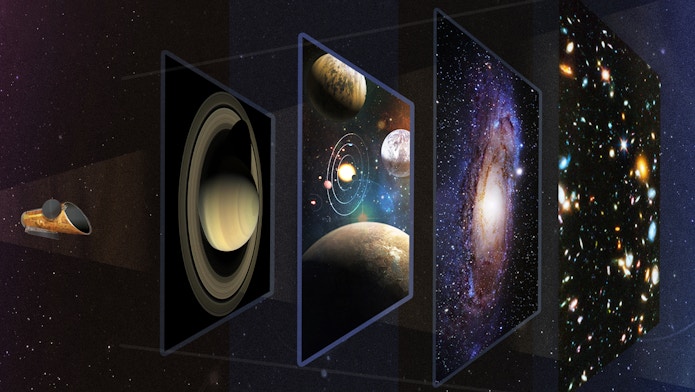Science with HabEx: UV to Near-Infrared Space Astronomy in the 2030s

The Habitable Exoplanet Observatory (HabEx) is one of four concepts currently under study by NASA in preparation for the 2020 Astrophysics Decadal Survey. HabEx is designed to be the next-generation great observatory that has the capability to address physics of the cosmos, cosmic origins, and solar system and exoplanet science. HabEx is a space-based, four-meter diameter telescope with ultraviolet, optical and near-infrared imaging and spectroscopy capabilities, and at least 50 percent of the primary five-year mission will be dedicated to community involvement through a competed and funded Guest Observer (GO) program.
The purpose of this meeting is to invite members of the community to present scientific investigations and observational programs that:
- Will be important and relevant in the 2030s.
- Can be specifically conducted — or could benefit from synergistic observations — with HabEx.
To apply to give a presentation, abstract submissions are due by September 7. The registration deadline to attend the meeting is October 1.
More information on HabEx can be found on the HabEx website. See the “Mission” tab for information on the telescope and instrument capabilities.
The most comprehensive information on HabEx can be found in the HabEx Interim Report.
-
Monday October 15
12:30 pm meeting room opens – informal discussions 1:00 - 1:10pm Welcome and meeting objectives (R. Somerville/B. Mennesson) 1:10 - 1:25pm Ultraviolet Spectrograph (UVS) Instrument capabilities (P. Scowen) 1:25 - 1:40pm HabEx Workhorse Camera (HWC) Instrument capabilities (D. Stern) 1:40 - 1:55pm Coronagraph instrument capabilities (B. Mennesson) 1:55 - 2:10pm Starshade instrument capabilities (B. Mennesson) 2:10 - 2:30pm Future Planet Formation Studies with HabEx (A. Roberge) 2:30 - 2:50pm UV and Optical Transit Spectroscopy in the Post-JWST Era (E. Kempton) 2:50 - 3:10pm Coffee Break 3:10 - 3:30pm Exploration of Gas Giants and Satellites with HabEx (W. Harris) 3:30 - 3:50pm Exploring Small bodies in the Solar System with HabEx (F. Marchis) 3:50 - 4:10pm UV Observations of Solar System Surfaces with HabEx (A. Hendrix) 4:10 - 4:30pm Ionizing Radiation over Cosmic Time with HabEx (S. McCandliss) 4:30 - 4:50pm Transient and Multi-Messenger Astrophysics with HabEx (B. Cenko) 4:50 - 5:10pm Local Relics of Black Hole Seeds in Dwarf Galaxies (A. Reines) 5:10 - 6:00pm Open discussion (co-led by A. Kiessling & D. Stern) 7:00 pm Conference Dinner Tuesday October 16
8:00 am meeting room opens – informal discussions 8:30 am Check-in and Breakfast 9:00 - 9:20am The Extragalactic Distance Scale in the 2030s (L. Macri) 9:20 - 9:40am Galactic Gas Flows: New Frontiers in UV Spectroscopy (J. Tumlinson) 9:40 - 10:00am Probing the Circumgalactic and Intergalactic Media (J. Bartlett) 10:00 - 10:20am Insights into Galaxy Evolution from Resolved Stars (K. McQuinn) 10:20 - 10:50am HabEx in the Era of ELTs (C. Dumas / R. Bernstein) 10:50 - 11:10am Coffee Break 11:10 - 11:30am Observing Galaxy Evolution in the UV with HabEx (H. Teplitz) 11:30 - 11:50am Galaxy Formation and Evolution (H. Ferguson) 11:50am - 12:10pm Physics of Star Formation in Central Cluster Galaxies (M. Postman) 12:10 - 12:30pm AGN Astrophysics with Exoplanet Instruments (S. Ford) 12:30 - 12:50pm Strong Lensing with HabEx (L. Moustakas) 12:50 - 1:50pm Lunch Break 1:50 - 2:10pm Massive Star Formation in the Local Volume with HabEx (D. Thilker) 2:10 - 2:30pm Evolved Massive Stars with HabEx (P. Morris) 2:30 - 2:50pm Biosignature Search Strategies and Opportunities with HabEx (G. Arney) 2:50 - 3:10pm Revisiting Oxygen False Positives in ExoEarth Atmospheres (S. Harman) 3:10 - 3:30pm Coronagraph Simulations for HabEx (A. Britt) 3:30 - 3:50pm Simulating Precursor Radial Velocity Surveys (P. Plavchan) 3:50 - 4:10pm Coffee Break 4:10 - 5:30pm Open discussion (co-led by A. Kiessling & D. Stern) 5:30 pm Adjourn -
HabEx archived powerpoint presentations and information can be found here.
-
Confirmed Speakers:
Speaker Affiliation Science with HabEx Giada Arney GSFC Search for life James Barlett JPL/Caltech CGM/IGM Rebecca Bernstein GMT Synergies with the GMT Amber Britt Fisk University Coronagraph design reference mission development Brad Cenko GSFC Massive black holes/ LISA Christophe Dumas TMT Synergies with the TMT Harry Ferguson STScI Galaxy formation and evolution Saavik Ford CUNY Black holes / nearby galaxies Sonny Harman GSFC/Columbia University Terrestrial exoplanet atmospheric chemistry Walt Harris University of Arizona Planetary atmospheres Amanda Hendrix Planetary Science Institute Solar System Surfaces Eliza Kempton University of Maryland Exoplanet transit spectroscopy Lucas Macri Texas A&M University Cosmology Franck Marchis SETI Institute Solar system science Stephan McCandliss Johns Hopkins University Emission and absorption processes of hydrogen Kristen McQuinn Yale Galaxy evolution / resovled stars Patrick Morris IPAC/Caltech Massive star evolution Leonidas Moustakas JPL Strong Lensing Peter Plavchan George Mason University Precursor RV Surveys Marc Postman STScI General astrophysics Amy Reines Montana State University Black holes / nearby galaxies Aki Roberge GSFC Circumstellar disks Harry Teplitz IPAC UV extragalactic observations David Thilker Johns Hopkins University Massive star formation Jason Tumlinson STScI Cosmic origins -
Participants should arrange their own hotel accommodations. The following hotels are recommended by the Flatiron institute:
The James Hotel, NOMAD, NYC
22 E 29th St, New York, NY 10016
(212) 532-4100
https://www.jameshotels.com/new-york/nomadThe Marcel at Gramercy
201 E 24th Street
New York, NY 10010
(212) 696-3800
https://themarcelatgramercy.com/Pod 39
145 E 39th St, New York, NY 10016
(844) 763-7666
https://www.thepodhotel.com/The Redbury New York
29 E 29th St, New York, NY 10016
(212) 689-1900
https://theredbury.com/newyork/>The Roger New York
131 Madison Ave, New York, NY 10016
(212) 448-7000
https://www.therogernewyork.com/W New York – Union Square
201 Park Ave S, New York, NY 10003
(212) 253-9119
www.whotelsnewyork.com/property/w-new-york-union-square/ -
John Clarke (Boston Univ.)
Shawn Domagal-Goldman (NASA-GSFC)
Scott Gaudi (OSU)
Alina Kiessling (NASA-JPL)
Bertrand Mennesson (NASA-JPL)
Ty Robinson (NAU)
Leslie Rogers (Univ. of Chicago)
Paul Scowen (ASU)
Sara Seager (MIT)
Rachel Somerville (Rutgers Univ./ Flatiron Institute)
Daniel Stern (NASA-JPL)
Keith Warfield (NASA-JPL)
-
Queries can be sent to:
Bertrand Mennesson (HabEx Study Scientist)
Bertrand.Mennesson@jpl.nasa.govScott Gaudi (HabEx Science and Technology Definition Team Co-Chair)
gaudi.1@osu.eduAlina Kiessling (HabEx Deputy Study Scientist)
Alina.A.Kiessling@jpl.nasa.govRachel Somerville (HabEx STDT Member and local Flatiron Institute host)
rsomerville@flatironinstitute.org